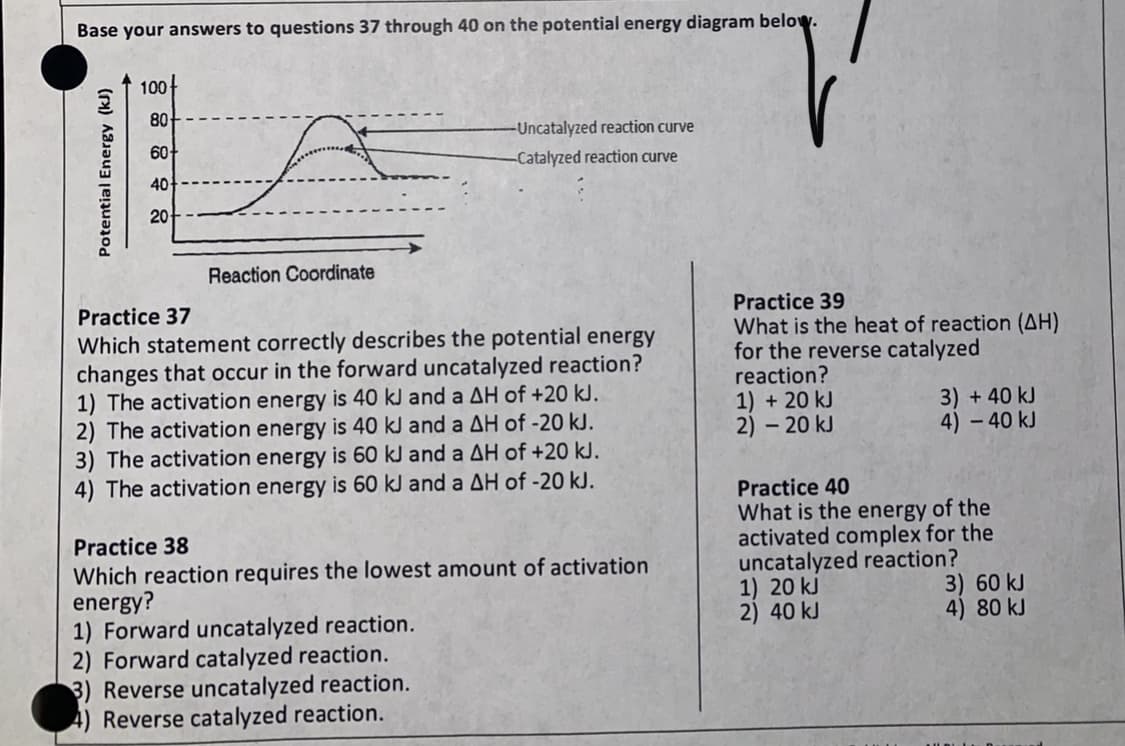Base your answers to questions 37 through 40 on the potential energy diagram below. 100- 80 -Uncatalyzed reaction curve 60 -Catalyzed reaction curve 40 20 Reaction Coordinate Practice 39 What is the heat of reaction (AH) for the reverse catalyzed reaction? 1) + 20 kJ 2) - 20 kJ Practice 37 Which statement correctly describes the potential energy changes that occur in the forward uncatalyzed reaction? 1) The activation energy is 40 kJ and a AH of +20 kJ. 2) The activation energy is 40 kJ and a AH of -20 kJ. 3) The activation energy is 60 kJ and a AH of +20 kJ. 4) The activation energy is 60 kJ and a AH of -20 kJ. 3) +40 kJ 4) - 40 kJ Practice 40 What is the energy of the activated complex for the uncatalyzed reaction? 1) 20 kj 2) 40 kJ Practice 38 Which reaction requires the lowest amount of activation energy? 1) Forward uncatalyzed reaction. 2) Forward catalyzed reaction. 3) Reverse uncatalyzed reaction. 4) Reverse catalyzed reaction. 3) 60 kJ 4) 80 kJ Potential Energy (kJ)
Base your answers to questions 37 through 40 on the potential energy diagram below. 100- 80 -Uncatalyzed reaction curve 60 -Catalyzed reaction curve 40 20 Reaction Coordinate Practice 39 What is the heat of reaction (AH) for the reverse catalyzed reaction? 1) + 20 kJ 2) - 20 kJ Practice 37 Which statement correctly describes the potential energy changes that occur in the forward uncatalyzed reaction? 1) The activation energy is 40 kJ and a AH of +20 kJ. 2) The activation energy is 40 kJ and a AH of -20 kJ. 3) The activation energy is 60 kJ and a AH of +20 kJ. 4) The activation energy is 60 kJ and a AH of -20 kJ. 3) +40 kJ 4) - 40 kJ Practice 40 What is the energy of the activated complex for the uncatalyzed reaction? 1) 20 kj 2) 40 kJ Practice 38 Which reaction requires the lowest amount of activation energy? 1) Forward uncatalyzed reaction. 2) Forward catalyzed reaction. 3) Reverse uncatalyzed reaction. 4) Reverse catalyzed reaction. 3) 60 kJ 4) 80 kJ Potential Energy (kJ)
Chapter17: Spontaneity, Entropy, And Free Energy
Section: Chapter Questions
Problem 23Q: Monochloroethane (C2H5Cl) can be produced by the direct reaction of ethane gas (C2H6) with chlorine...
Related questions
Question
FYI: 37-40 is like a),b),c) and d)

Transcribed Image Text:Base your answers to questions 37 through 40 on the potential energy diagram below.
100-
80
-Uncatalyzed reaction curve
60
-Catalyzed reaction curve
40
20
Reaction Coordinate
Practice 39
What is the heat of reaction (AH)
for the reverse catalyzed
reaction?
1) + 20 kJ
2) – 20 kJ
Practice 37
Which statement correctly describes the potential energy
changes that occur in the forward uncatalyzed reaction?
1) The activation energy is 40 kJ and a AH of +20 kJ.
2) The activation energy is 40 kJ and a AH of -20 kJ.
3) The activation energy is 60 kJ and a AH of +20 kJ.
4) The activation energy is 60 kJ and a AH of -20 kJ.
3) +40 kJ
4) – 40 kJ
Practice 40
What is the energy of the
activated complex for the
uncatalyzed reaction?
1) 20 kJ
2) 40 kJ
Practice 38
Which reaction requires the lowest amount of activation
energy?
1) Forward uncatalyzed reaction.
2) Forward catalyzed reaction.
3) Reverse uncatalyzed reaction.
4) Reverse catalyzed reaction.
3) 60 kJ
4) 80 kJ
Potential Energy (kJ)
Expert Solution
This question has been solved!
Explore an expertly crafted, step-by-step solution for a thorough understanding of key concepts.
This is a popular solution!
Trending now
This is a popular solution!
Step by step
Solved in 2 steps with 2 images

Knowledge Booster
Learn more about
Need a deep-dive on the concept behind this application? Look no further. Learn more about this topic, chemistry and related others by exploring similar questions and additional content below.Recommended textbooks for you


Chemistry
Chemistry
ISBN:
9781305957404
Author:
Steven S. Zumdahl, Susan A. Zumdahl, Donald J. DeCoste
Publisher:
Cengage Learning

Chemistry: An Atoms First Approach
Chemistry
ISBN:
9781305079243
Author:
Steven S. Zumdahl, Susan A. Zumdahl
Publisher:
Cengage Learning


Chemistry
Chemistry
ISBN:
9781305957404
Author:
Steven S. Zumdahl, Susan A. Zumdahl, Donald J. DeCoste
Publisher:
Cengage Learning

Chemistry: An Atoms First Approach
Chemistry
ISBN:
9781305079243
Author:
Steven S. Zumdahl, Susan A. Zumdahl
Publisher:
Cengage Learning

Chemistry for Engineering Students
Chemistry
ISBN:
9781337398909
Author:
Lawrence S. Brown, Tom Holme
Publisher:
Cengage Learning

Chemistry: The Molecular Science
Chemistry
ISBN:
9781285199047
Author:
John W. Moore, Conrad L. Stanitski
Publisher:
Cengage Learning

Organic Chemistry
Chemistry
ISBN:
9781305580350
Author:
William H. Brown, Brent L. Iverson, Eric Anslyn, Christopher S. Foote
Publisher:
Cengage Learning